Monday, September 17th, 2012...1:50 pm
Not Quite Dolsot Bibimbap
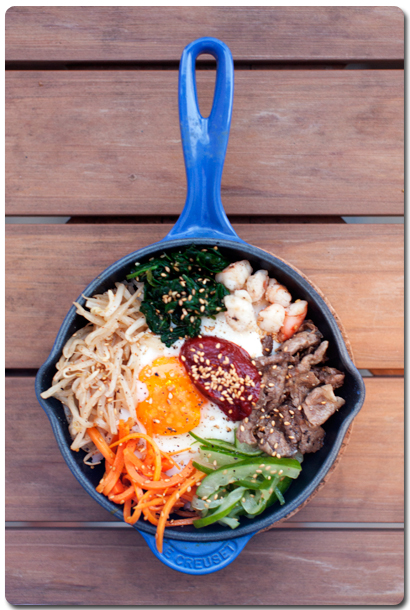
I’ve never been the biggest fan of Korean food. A big part of this is probably because I don’t like kimchi, and – I know this is probably going to make me sound like an ignorant fool, but – half the meal always seems to revolve around the stuff! The one exception I can’t get enough of, though, is Korean fried chicken. Not just any flavour – I tend to find the sweet and spicy sauce (which is the most commonly available flavour) way too sweet and sticky for my liking – but the spicy soy garlicky sort. I love it so much that I always make sure that I get at least one or two meals at Kko Kko Nara in whenever I’m in Singapore.
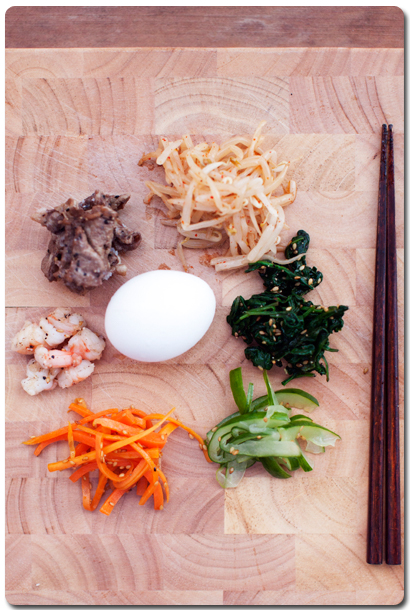
This obsession with Kko Kko Nara has led me on a hunt for similarly awesome Korean fried chicken in Hong Kong. And in doing so, I’ve been forced to try more Korean dishes that have, thankfully, expanded my gastronomic horizons past kimchi soup and bulgogi. One dish that I’ve recently discovered a taste for is bibimbap. Literally, mixed rice, my favourite incarnation of this is dolsot bibimbap, where the rice and its myriad toppings are served at the table in a heated stone bowl, so you get that crispy crust of slightly charred rice (known as nurungji, similar to the Spanish socarrat in paella), and, of course, there’s always the fun of being allowed to play with your food at the dinner table. Depending on the restaurant you dine at, the egg will either be cracked into the rice raw (the heat from the ingredients and the stone bowl will cook the egg), or served atop the rice (often over the rest of your ingredients) as a fried egg. I am partial to the latter method, as it means I’ll get bits of crispy, nicely browned white in my rice once it’s mixed up, as opposed to having most of the rice coated with egg, which I find makes it a little soggier.
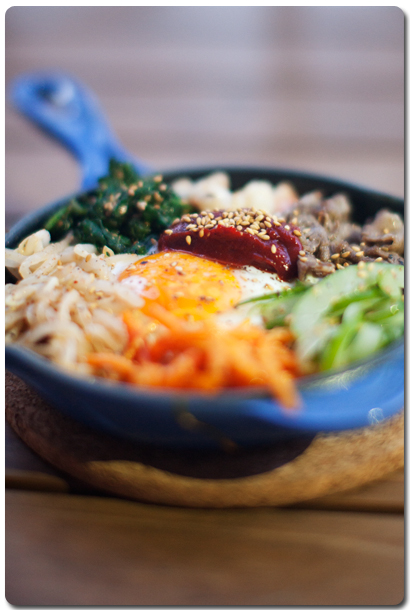
Being a bit of a nerd, almost every obsession with any particular dish inevitably leads to me wanting to recreate it at home. Which, of course is what I did here. A quick spot of googling threw up a bunch of Korean food blogs and a quick scan of the recipes led me to believe it’d be a pretty easy task to undertake. Little did I realise, the reason this dish is often listed as something you can throw together in 15 minutes for a “quick weeknight dinner” is because plenty of Korean households will already have all of the toppings prepared in advance, and all that remains is heating everything up, and possibly stir-frying the protein topping. Don’t let the seemingly long list of things to do unnerve you, though – each task is pretty simple, and it’s mostly very repetitive. In fact, I was joking with the friends that came over for the bibimbap experiment that the secret to Korean cooking doesn’t lie with kimchi, but with sesame oil and sesame seeds! (Apologies if I’ve just maligned and/or butchered the Korean way of cooking though, haha.)
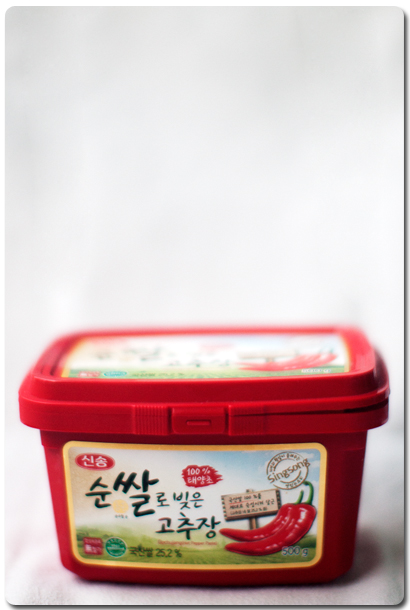
That said, one of the fun things about making a dish like bibimbap at home is that you get to customise it to your tastes. Feeling vegetarian? Substitute firm or fried tofu for the beef! Don’t like seafood? Leave the prawns out. Add more cucumber or beansprouts if you like, or have extras lying around in your fridge that you want to use up. The only thing I’d say you can’t compromise on is the gochujang – a sweet and spicy Korean fermented bean and chilli paste. Because I don’t have a Korean dolsot, or stone bowl, I preheated a cast iron pan in place. If you have multiple smaller pans (like the blue 6-inch Le Creuset pictured at the start of the post), you can serve everyone’s bibimbap individually, or just do one bigger one in a 10 to 12-inch pan which you can place in the middle of your dining table for everyone to serve themselves communally from.
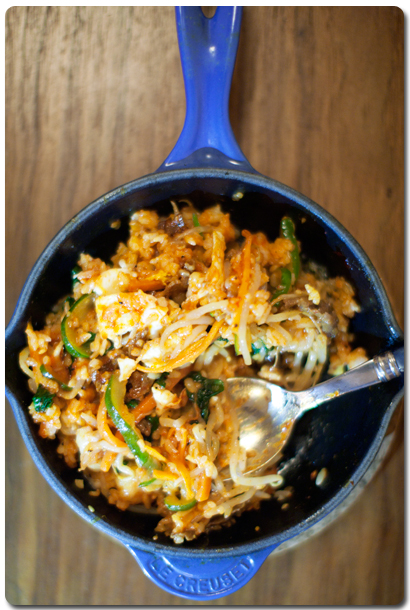
Cast-iron Bibimbap
1 medium cucumber, peeled, seeded and thinly sliced into long strips
1 cup beansprouts
2 cups fresh spinach leaves
1 medium carrot, peeled and julienned
3-4 prawns, shelled and roughly choped
120g thinly sliced beef (I used short rib)
3 cloves garlic, minced, divided
1 tsp mirin
1 tsp sugar
1/2 tsp chilli powder (optional)
fish sauce or soy sauce
toasted sesame seeds
salt & freshly ground black pepper
2 eggs
2 cups cooked rice (preferably short-grain)
2-4 tbsp gochujang (or to taste)
To prepare the cucumber, place the cucumber strips in a nonreactive bowl, and season with about 1/2 tsp salt. Mix well, and set aside for 20-30 minutes. After 20 minutes, drain the cucumber in a sieve or small colander, and gently squeeze out any excess moisture. Set aside. (Can be prepared up to 1 day in advance.)
To prepare beansprouts, bring a large saucepan of salted water to the boil over medium heat. Add the beansprouts, and simmer until tender, but not soggy (about 6-8 minutes). Drain, running beansprouts under cold water to stop the cooking process. Season with a pinch of salt, 1 tbsp of sesame oil, 1/2 tsp of chilli powder, if using, and set aside. (Can be prepared up to 3 days in advance.)
To prepare spinach, prepare an ice bath. Bring a large saucepan of salted water to the boil over high heat. Add the spinach, cooking until just wilted but still a vibrant deep green colour. Drain and plunge the spinach into the ice bath to stop the cooking and preserve the colour of the vegetables, then drain immediately, squeezing out any excess moisture. Season with 1 tsp sesame oil, a pinch of salt, 1 tsp sesame seeds, and a couple of twists of black pepper. (Can be prepared up to 3 days in advance.)
To prepare the carrots, heat 1 tsp of sesame oil in a sauté pan over high heat. Add 1/3 minced garlic, and sauté until fragrant. Add in the carrots, season with a pinch of salt, and stir-fry until tender, but still maintains a little crunch (about 3 minutes). Set aside. (Can be prepared up to 1 day in advance.)
To prepare the prawns, heat 1 tsp of sesame oil in a sauté pan over high heat. Add prawns, season lightly with salt and a dash of fish sauce or soy sauce, cooking until the pieces are completely opaque. Set aside. (Can be prepared up to 1 day in advance.)
To prepare the beef, heat 1 tsp of sesame oil in a sauté pan over medium-high heat. Sauté the remainder of the minced garlic until lightly browned and fragrant, then add the beef. Season with 1 tsp mirin, 1/2 tsp sugar, fish sauce or soy sauce (about 1 tsp, or to taste, and lots of pepper. Cook until liquid has evaporated, then stir in 1 tsp of sesame seeds, remove from heat and set aside. (Can be prepared up to 1 day in advance.)
Fry the two eggs, sunny-side up, until the edges of the white are a little crispy, but the yolk is still runny.
To assemble the bibimbap, preheat two 6-inch cast iron pans for about 5 minutes on medium heat. Add 1 tbsp sesame oil to the base of each pan, swirling to coat evenly. Add in half the rice to each pan, spreading it evenly over the surface. Top with a fried egg in the middle of the rice, then add half of the beef, prawns, carrot, spinach, cucumber, and beansprouts to each pan around the yolk. Top with a generous dollop of gochujang, sprinkle the entire pan with a little more sesame seeds. Cook, for about 3-5 minutes (this will allow any refrigerated ingredients to be heated through, and start the formation of the nurungji.
Bring to the table, being careful to place each pan on a trivet (both the pan – including the handle – and its ingredients will be very hot). Each diner can mix the ingredients into the rice on their own.
Yield: Serves 2

Comments are closed.